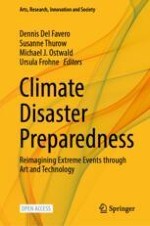This chapter considers alignment issues for immersive environments that stage extreme event scenarios for the purposes of preparation. To show what an aligned project might look like, we are using the
iFire system, which is currently in development at the University of New South Wales’s iCinema Research Centre. These sorts of environments have the potential to use visualisation and immersive experiences to inform perception, expectations and responses to wildfires (Hoang et al.,
2010; Altintas et al.,
2015). To create significant impact, these systems require a unique combination of accuracy as well as aesthetic and conceptual verisimilitude—a challenging combination in high-stakes ethical and decision-making situations. These systems are urgently needed because we are facing rapidly shifting fire landscapes around the world under a changing climate, which see a significant increase in extreme fire events. In response, AI capabilities are being developed to assist rate-of-spread (RoS) prediction and decision making in uncertain scenarios. The form of these systems and their potential usability for fire management requires an alignment model that ensures that the two key non-moral values—
accuracy and
verisimilitude—are maximised to achieve the overall goal for such systems: to generate insight and enhance preparedness for extreme event scenarios. This chapter provides a theoretical study of these alignment issues, developing an account of the efficacy of verisimilitude techniques, which range from ‘storyline’ to ‘scenario’ and ‘simulation’ theories—when they are placed in an interpretable framework. ‘Alignment’ is the guiding principle for circumscribing or shaping artificial intelligence (AI) actions to conform to human values, so that these systems successfully achieve human goals while minimising harm (Yudkowsky,
n.d.). Alignment is a broad field that seeks to bring together intentions, values and contingencies. It is shaped by the nature of the impressions or assumptions that underlie our relations with AI—it is an “overarching research topic of how to develop sufficiently advanced machine intelligences, such that running them produces good outcomes in the real world” (Arbital,
n.d.). Given the contestability of normative ethics, each alignment problem involves interrogating and defining what these ‘good outcomes’ might look like and the boundaries where the ‘good’ bleeds into the problematic, harmful and potentially catastrophic. The classic ‘alignment story’, whose origins are unclear, involves an AI machine that is designed to create paperclips, an apparently innocuous task. Through intelligence explosion and an optimisation process, this imagined paperclip machine creates a situation where it transforms “earth and then increasing portions of space into paperclip manufacturing facilities”—Armageddon in the name of wire squiggles (Yudkowsky,
n.d.). This is a tale about the unknown capacities of an artificial general intelligence (AGI), and it is also, of course, a tale ad nauseam. Values are profoundly contingent, and value-oriented questions revolve around the modification, interpretation and application of multiple competing values and their individual limits. While this sort of imagined situation demonstrates the dangers of a naive application of goals in an exceptional AGI, it does not venture into the theatrically modest but conceptually more difficult territory of Janus-faced AI systems whose goals are also values: where a goal is inherently collaborative, as in multi-agent systems, or where the relevant values are not moral. This form of alignment can be achieved through an application of ‘interpretable’ strategies, which involve explicit articulation of qualitative techniques including, for example, ‘insight’. Interpretability is a distinct problem of AI explainability and involves qualitative methods and case-by-case development. While AI explainability (XAI) is the process where AI decision-making processes are made transparent, interpretability refers to a broader, human-centred process that involves contextualised explanations. Interpretability recognises that any “ML decision is explained differently, depending on the person to whom it is explained, the reason why the explanation is needed, the place and time of the explanation, the ergonomics of human-machine interaction, and so on” (John-Matthews,
2022). The application of strategies theorised in scenario studies, psychology and climate science provides qualitative methods that can fulfil the need for interpretability and achieve alignment. This chapter surveys a series of methods, chief among these Theodore Shepherd’s concept of ‘storylines’ (
2019), which are defined as “physically self-consistent unfolding of past events, or of plausible future events or pathways” with no ‘a priori probability’ attached. In application to
iFire, we couple this method with a theory of affect-informed ‘simulations’ of uncertainty (Anderson et al.,
2019) and scenarios organised around perceived or discovered vulnerabilities (Lempert,
2013). Simultaneously, we show that an immersive environment has the capacity to offer the sort of “embedded experience” that climate science sorely lacks (Jasanoff,
2010; Shepherd & Lloyd,
2021).
